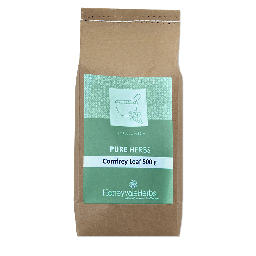Comfrey (Symphytum officinale)
Comfrey is widely known for its remarkable healing properties for ulcers, broken bones and soft tissue damage. It has cell proliferant properties which promote speedy wound healing, for which it can be used both internally and externally.
It’s also very soothing for the mucous membranes, as well as being an expectorant, so it is excellent to include in any respiratory herbal blend. It also improves circulation, and is helpful for treating arthritis.
Promotes healing of bone, skin, cartilage and muscle tissues (included in our Bone & Tendon Repair blend)
Promotes healthy hoof growth (included in our Hoof Grow blend)
An aid in conditioning the stomach lining and helps to relieve gastric ulcers (included in our Ulcer-Ease blend)
Promotes healthy lung functions (included in our Breathe-Ease blend
Feeding Instructions:
The following dosages should not be exceeded. Mix into daily food.
- Horses: 1-2 handfuls in feed daily (approximately 10-15g)
- Ponies: ½ -1 handful in feed daily (approximately 6-10g)
- Dogs and Cats: ½ to 1 teaspoon per 500g of food
- Pigeons and Poultry: Up to 2% of daily grain feed. Mix well into feed together with a little vegetable oil.
Warnings:
- Do not feed to pregnant animals, or pets with liver disease.
- Comfrey contains small quantities of alkaloids that can cause liver damage if taken in large quantities:
“The Comfrey Debate:
Regrettably, the internal use of Comfrey has been a much misunderstood and frequently controversial subject since the late 1960’s. The presence of a group of compounds contained in Comfrey called pyrrolizidine alkaloids (PA’s) instigated concern during a Japanese study on lab rats in 1968, which involved injecting high concentrations of isolate symphytine alkaloid in sufficient dosages that it would represent a staggering 33% of a rat’s daily food intake!
Herbalists argue that this is a totally unrealistic representation – as to begin with, in order to replicate the experiment in horses, they would have to ingest 150kg of isolate symphytine daily, and because symphytine only represents a tiny portion (5%) of total PA’s, this would mean a horse would have to consume a staggering 8,33 tonnes per day of dried comfrey! To add further perspective, PA’s are not uncommon in many foodstuffs – for example, both red wine and dark chocolate contain concentrations of PA’s.
Herbalists argue that:
The concentration of symphytine used in the trials was completely unrealistic
Injected substances can have a vastly different effect on the body, compared to those delivered orally
Substances given in extracted isolation can behave very differently than if they are delivered in a balanced whole-herb form e.g. Aspirin is extracted from Meadowsweet. Aspirin aggravates gastric ulcers in its extracted form, but Meadowsweet in its whole form is one of the best ulcer healing herbs
The species of Comfrey used in the trials were not specified, and the presence of symphytine varies greatly depending on species, and parts of the herb used (the root has a far higher concentration of symphytine than the leaves). Prickly Comfrey (Symphytum asperum) and Russian Comfrey (Symphytum x uplandicum) contain a far higher concentration of PA’s than English (also known as Common) Comfrey (Symphytum officinalis). The presence of symphytine in English Comfrey leaves is barely traceable.
The detractors also ignore the history of Comfrey’s safe and extensive usage as a bulk fodder crop for both cattle and horses (much revered by farmers) in Europe since the 1840’s.”
Use only as directed, and for short periods of time (1-2 weeks)
Specifications
| Size | 500 g |

To install this Web App in your iPhone/iPad press ![]() and then Add to Home Screen.
and then Add to Home Screen.





